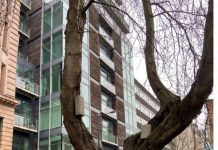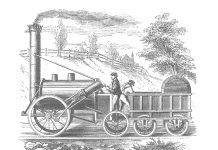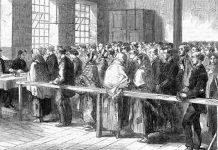While most people know of Manchester’s Roman fort at Castlefield, the route that the Roman legions took as they headed over the Pennines to subdue the Brigantes in modern day Yorkshire and beyond is less known and yet it has left its mark on Manchester.
Wondering why Deansgate goes in a straight line,well it was the beginning of the road east but there is more veidence along the route.
Walk along Bradford Road,cross the busy Hulme Hall Lane past Philips Park and up Briscoe Lane towards Newton Heath and you may find something a little strange.
Yes the road is dead straight and the reason for that is it was the course of a Roman road which would convey legions from the Roman fort of Mancestre across the Pennines to York and beyond.Built by Agricola, who founded Manchester’s settlement at Castlefied,it marked the route that the Roman legions followed to subdue the local tribes.
The road originated in Chester,the base from where the Romans had taken control of North Wales, coming to Manchester via Northwich and running along the present Chester Road past Old Trafford and onto Deansgate,passing about 100 yards south of the walled castle near the confluence of the Medlock and the Irwell, the Mamucium from which Manchester got its name.(a short branch road on the north of the Medlock would take it to the East gate).
As the legions sought to advance East aiming to isolate the Brigantes tribe in the Pennines uplands,the road was constructed through what is now East Manchester.
The 18th century historian Whitaker traced it along Deansgate before following the line of Travis Street and along Mill Street in Ancoats before entering the Newton township to the West of Hulme Hall Lane.
He found 150 yards of the ridge still visible at Cheetham Fold and found further traces between Newton Heath and Failsworth.
The best description as it travels through East Manchester came from it probably marks the Roman advance from the west against the Brigantes inhabiting the highlands of the middle of England
In a lecture to the Manchester Literature and Philosophical society,Dr Thos Percival described its course through East Manchester as follows:
“It crosses the very middle of Newton Heath,the chapel standing on the very ridge of it ,standing at the west end of the chapel,you see the trace of it into Bradford lane.Standing at the East end you see the trace of it go behind a house and a barn on the East end of the common.It then runs through the enclosures to Mr Wagstaffs house where it enters alone and is visible enough.
In about 400 yards more,being interrupted by a moss,it rises with a prodigious grandeur and is the finest remains of a Roman Road in England that I ever saw.It is visible for half a mile more along a back lane leading to Hollingwood but on the lane turning to the common it strikes across a meadow of Mr Whitehead’s and is visible for a small part of it.”
A morass had caused its preservation in Failsworth,along what is now called the Roman Road, where the mosses having been drained had left the road showing in the ridge ,the paved surface had gone by Whitaker’s time leaving only gravel but it was in places six yards high.
Part of the road was uncovered during work in the mid nineteenth century.An article in All Saint’s Parish magazine spoke of the road being made by laying large oak beams across the boggy parts along Broscoe Lane and in Gaskell Street, a farm labourer had found thirty oak logs so decayed that they could only be used for firewood.
Then Briscoe Lane was still a proper country style unpaved lane,the houses then just on one side of the road ,already considered old with flagged flooring and long gardens.Along from them, the village pinfold where the constable would drive straying cattle into the shed if they were found on the lane late at night,the owners would have to pay a small fine the next morning to recover them
It was to be the last glimpse of the Roman legacy in the parish.The ridge beyond Failsworth disappeared, but near the Hollinwood Cemetery it becomes before all trace of the road is lost as it climbs towards Oldham.
From Oldham the road ran through Austerlands and Delphi eventually to Castleshaw where remains of a Roman camp can still be seen.








Only researched north east as far as the Manchester boundary.
Briscoe La lines up with Roman Rd Failsworth which in turn lines up with Honeywell La and over Glodwick Lows where there is, allegedly, evvidence of a Roman Road before pointing directly to tthe Roman fort at Castleshaw above Delph